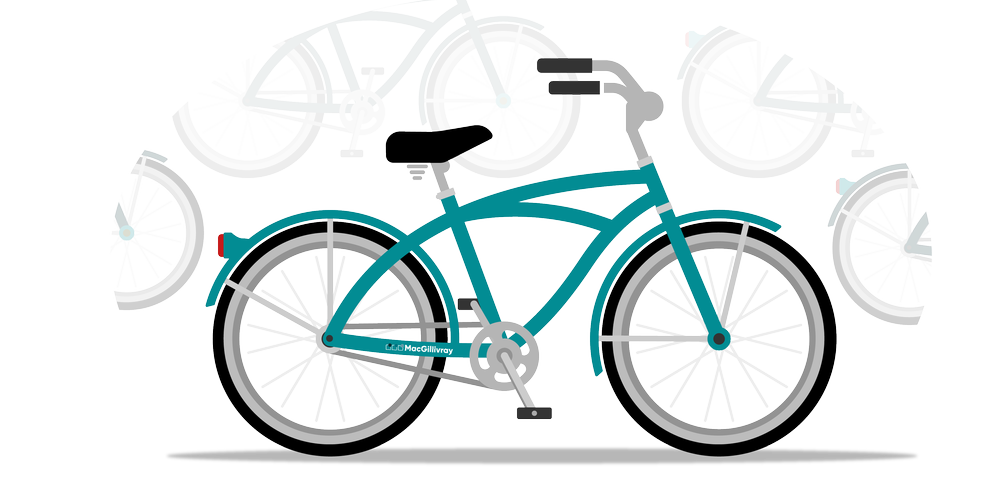




Accidents involving cyclists and vehicles can lead to serious injury
Bicycling is a healthy, affordable, and energy-efficient means of transportation that has gained popularity over the past few years. In catching up with this popularity, bicycle traffic has increased, and bicycle lanes have been sprouting up across small towns and major cities in Canada. Unfortunately, cyclists are relatively unprotected while commuting near motor vehicles, even when wearing protective gear like a helmet or guards. When a collision between a motor vehicle and cyclist occurs, the result can be catastrophic to the cyclist.
Common causes of bicycle accidents
- Ignorance of the rules of the road
- Car-dooring
- Poor road conditions, such as ruts or potholes
- Failure to stop at a stop sign
- Distracted or inattentive drivers
- Drivers passing cyclists on a blind crest
Common cyclist injuries
- Road rash
- Broken teeth
- Facial injuries, such as damage to eyes, nose, and jaw
- Traumatic brain injuries
- Fractured bones
- Soft-tissue injuries
- Neck and back injuries
- Psychological injuries, such as PTSD and anxiety
- Death
After an accident, it is common for people to experience shock and not feel pain immediately. Some injuries may only present themselves days or weeks later. Following up with a medical provider is essential in ensuring that injuries are diagnosed and treated properly.
What should a cyclist do after being hit by a car?
After being hit by a car, truck, bus, or other motor vehicle, a cyclist may experience severe acute injuries or shock. In this state, it may be difficult to impossible to gather information.
When possible, a cyclist who has been hit by a driver should gather as much information as they can about the accident. This includes the name, contact information, and insurance policy details of the driver, and make and model of the vehicle involved. Where a witness is involved, the witness should provide their name and contact information to the police so they can be contacted if needed. Photos of the location, vehicle, bicycle, and injuries can be valuable in determining fault for the accident. The moments after an accident are critical for establishing a record of what occurred and keeping track of the parties involved if legal action arises.
When a driver involved in an accident with a cyclist is uninsured or flees the scene (hit and run), the cyclist still has recourse to seek compensation. To learn how damages can be recovered in these situations, see How can pedestrians hurt in an accident be compensated?
After seeking medical attention, the injured cyclist should consult with a lawyer experienced in handling bicycle accident claims. There is a time limit on how long someone has after an accident occurs and when they must begin a lawsuit. This is called a limitation period. For a typical bicycle accident, this period is 2 years, however, certain factors can change its duration.
What does a cyclist injured in a car accident need to prove?
Typically, when an injured party sues another for damages, the burden is on the injured party to prove that the other party was at fault for the accident and their resulting injuries. In other words, the law places the responsibility on the injured to demonstrate that the other party was “more likely than not” responsible for their injuries.
Since bicycles are not motor vehicles, cyclists are treated the same way as pedestrians by the relevant legislation. In some provinces, the burden of proof falls on the injured cyclist to prove that the other party caused their injuries, as in most personal injury claims. However, in other provinces, like Nova Scotia, Prince Edward Island, and Ontario there is a reversal of this burden, and the driver is responsible for proving that they were not at fault for the accident. Where this “reverse onus” applies, the cyclist need only prove that the accident occurred and caused their injuries.
What insurance benefits are available to cyclists injured in an accident?
Cyclists are not required to be insured to ride bicycles. Therefore, they are largely treated by the law the same as a pedestrian. Typically, where a driver is found totally or partially at fault for the accident, the driver’s insurance policy will compensate the cyclist for their injuries. However, when a cyclist is covered by an automobile insurance policy, their own coverage will step in for the no-fault benefits portion of their claim.
In Atlantic Canada, no-fault benefits are covered by Section B insurance coverage.
In Ontario, no-fault benefits are covered by Statutory Accident Benefits.
The law
Like drivers, cyclists must adhere to the obligations set out in the relevant legislation of the province in which they are riding. As cyclists do not have to follow lessons or pass a test prior to heading onto the road, it is up to cyclists to adopt safe cycling practices and ensure they know the rules of the road. Drivers should take care as well to learn the rules of the road where cyclists are concerned.
Helpful guides for bicycle rules:
Nova Scotia – https://bicycle.ns.ca/rules-of-the-road/
New Brunswick – https://laws.gnb.ca/en/showdoc/cs/M-17/ga:s_176#anchorga:s_176
Prince Edward Island – https://peicyclingtours.ca/pei-bicycle-laws
Have questions for our team?
Frequently Asked Questions
- What happens when a cyclist is partially at fault for an accident?
- How can a lawyer help with my personal injury claim?
- Should I accept the settlement my insurance company offers me?
- How much is my injury claim worth?
- How can I help my personal injury lawsuit to get the best settlement?
- How long does a personal injury claim take?
Request a
Free Consultation
If you would like to learn your legal options at no obligation, contact us today to set up a free consultation.












